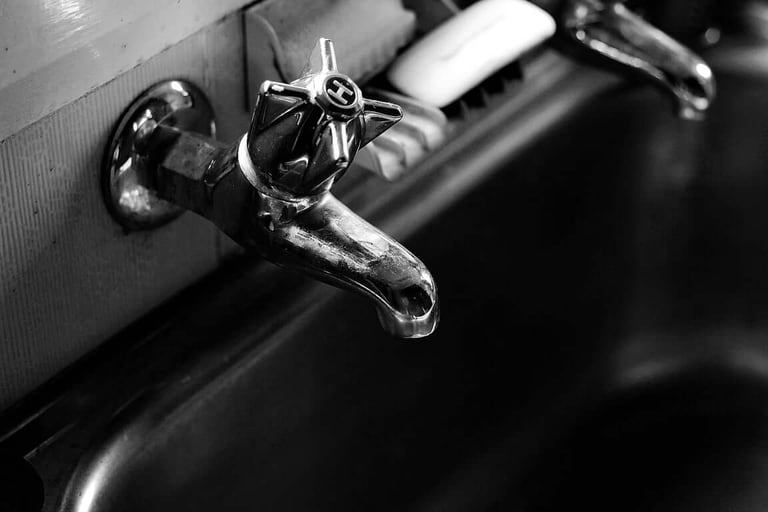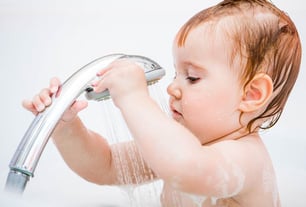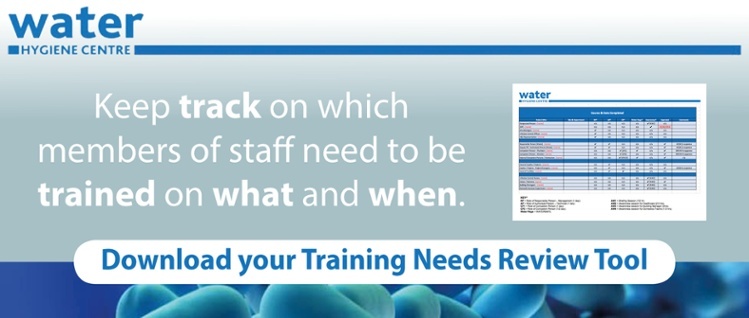This blog outlines some of the risks associated with scalding to which vulnerable individuals may be exposed when bathing or showering, as well as the key measures required to protect them.
NHS England has a “never events” policy. A “never event” is defined as ‘a serious, largely preventable, incident that should not occur if the available preventative measures have been implemented by healthcare providers’. Scalding of patients and others is on the list of “never events” in the NHS.
Vulnerable People at risk from Scalding
Your scalding risk assessment should cover all hot or blended water outlets present within the area to be assessed, and each outlet should be appraised for temperatures that may cause scald and its potential for:
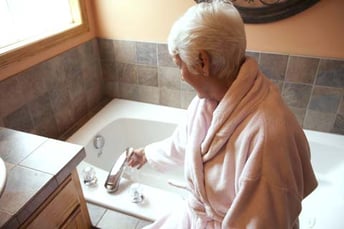 Whole body immersion;
Whole body immersion; - Use by individuals with mobility impairment;
- Use by individuals with sensory impairment;
- Use by the elderly, infants, or young or vulnerable children;
- Use by any other individuals who cannot react appropriately, or quickly enough, to prevent injury;
- Use by individuals who may have learning difficulties or other mental health conditions (e.g., a tendency to self-harm, dementia) that may predispose them to risk;
- The potential to use hot water as a means to harm others (e.g., prisons, mental health units). In addition, the risk assessment should also consider any lifting or other aids that may limit mobility in the bath or elsewhere, and any furniture, fixtures, and fittings that may restrict movement away from the source of heat
Hot Water Temperature
Hot water temperatures above 44°C for showering or bathing (full body immersion) represent an increased risk of serious injury due to scalding. When large areas of the body are exposed to high temperatures, scalding injuries can be severe and could result in a fatality.
Where the intention is for supervised, whole-body (or, depending on the circumstances, partial) immersion, the temperature of the water to be used should always be checked beforehand by a competent care professional using a suitable thermometer and recorded. The risk assessment should confirm that an adequate procedure is in place.
Water Hygiene Safety
Controlling water temperatures is a crucial aspect of water safety. For example, to minimise the growth of waterborne pathogens and keep any associated risk of infection as low as reasonably practical, there is a need to circulate hot water at temperatures above 50°C (55°C in healthcare premises) and to ensure that cold water temperatures remain below 20°C. There is a requirement, therefore, to put in place measures to control the maximum hot water temperature at outlets in areas where vulnerable people are likely to access.
Scalding Risk Assessment
There is a need to undertake a scalding risk assessment to understand the risks and to inform the measures necessary to prevent or control them. The risk assessment will include the water systems within the building, from the incoming supply to the cold water storage & distribution, as well as all the plant equipment used to generate, store, and distribute hot water throughout the premises. The risk assessment will include all outlets, such as. wash hand basins, showers, baths, toilets, hi-lo baths, hot drinks boilers, and ancillary sinks.
There is also a requirement to carry out a general scalding risk assessment on each person receiving care, considering the following:
- Likelihood that the user will require the use of a bath or shower;
- Capability/competence of the person who will run a bath or shower - whether this is the user or whether there is someone else who might do this for them;
- Lack of mobility and or ability to respond to hot water, i.e., being able to get out of the shower or bath if the hot water is too hot;
- Sensitivity to temperature;
- Having a mental state that cannot recognise or react to hot water;
- Ability to summon assistance;
- Complexity of medical condition.
Engineering Controls
To restrict the temperature of hot water at an outlet, a Thermostatic Mixing Valve (TMV) is fitted locally to the outlet (such as a wash hand basin, bath, or shower) to regulate the temperature. Thermostatic Mixing Taps (TMT) are also used, where the thermostatic control mechanism is integral to the tap. The desired output temperature will vary depending on the application. In non-healthcare premises, the temperature of hot water should not exceed 44°C. In healthcare premises, this is determined by the type of outlet, as per the guidance outlined in HTM 04-01: Supplement. Performance specification D 08: thermostatic mixing valves (2017), Table 17:
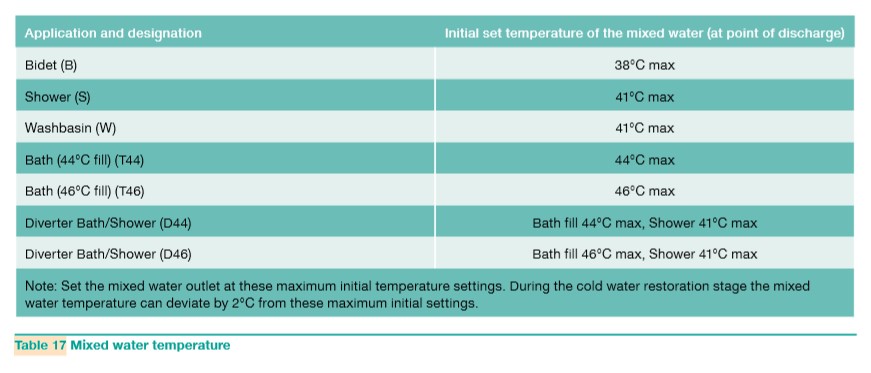
A Type 3 TMV is required for all healthcare premises where scalding has been identified as a potential risk to patients/end users. Where electrically heated showers are present, the temperature control must be maintained under all conditions, including surges or reductions in cold water flow/pressure. The hot and cold water systems also require adequate maintenance and monitoring by competent staff.
Training
There should be adequate Legionella training and supervision for staff involved in the care of people generally. The same applies to staff involved in the maintenance and monitoring of water systems in Health and Social Care premises.
What can go wrong?
A quick round-up of related news articles reveals that scalding problems are not uncommon. The summary below links to some interesting articles and highlights the deficiencies reported in each case:
Pensioner's hotel scalding death could have been prevented.
The failure of safety components in an unmaintained bath tap resulted in scalding water filling the bath. The HSE investigation found that the mixer tap in the bathroom was more than 30 years old, and its temperature control was "very sensitive,” which did not satisfactorily isolate the hot water when the cold water was shut off. This highlighted the lack of, not just annual, but any maintenance of the tap and its components.
Aster Healthcare fined £1m over woman's scalding bath death.
A lack of qualified engineers and care home staff, false water temperature readings reported to the CQC and HSE, along with falsified records of TMV’s service history, led to a substantial £1m fine and jail sentences for the Care Home Manager and Carer, who both pleaded guilty. Since this incident, Aster Healthcare has made changes to training, policy, and risk assessment.
Edinburgh hotel pays compensation over shower scalding death.
Although no Fatal Accident Inquiry was undertaken, questions were raised about whether the hotel failed in its duty of care by not having fitted a thermostatic mixing valve to regulate water temperature.
Ark Housing Association fined after the death of a man in bath scalding 
The housing association pleaded guilty to two contraventions of the Health and Safety at Work etc. Act 1974 (HSWA 1974). Ark was fined £75,000 and, after cooperating with the HSE, took steps to prevent future incidents. These steps included installing thermostatic mixer valves where necessary, providing suitable thermometers, training staff, and implementing written instructions for bathing and showering.
A woman died after Greencroft Residential Home scalding.
There was no effective control over the temperature of the hot water at the premises, no risk assessment had been carried out, and there had been little staff training, resulting in a £5,000 fine for breaching health & safety rules.
Care home to pay £145,000 over teenager's scalding death
An HSE investigation revealed that although the bath used was fitted with a special valve to prevent scalding, this valve was never set. Staff at the home were also found to have no training in managing the risks of scalding, or a suitable bath thermometer in place. The precise bath temperature was unknown, but the taps could deliver water at around 66 °C.
Housing association to pay £135,000 over scalding death
A 75-year-old sustained burns to 40 per cent of his total body surface area after water was at a temperature of between 60 and 65 °C. Midland Heart, the largest housing group in the Midlands, admitted to two breaches of s3(1) of the HSWA 1974 for failing to ensure the water outlet temperature had been correctly controlled to avoid scalding. They have subsequently invested money to minimise the risk of scalding accidents and installed thermostatic mixer valves on their baths.
References
- Health and Safety at Work etc Act 1974 Section 3
- Management of Health and Safety at Work Regulations Regulation 3
- Provision and Use of Work Equipment 1998
- L8 Legionnaires’ disease - The control of Legionella bacteria in water systems (2013)
- HSG 274 Part 2 The control of Legionella bacteria in hot and cold water systems
- HTM 04-01 Safe Water in Healthcare Premises Parts A, B and C 2016
- HTM 04-01 Supplement Performance Specification D08 thermostatic mixing valves (healthcare premises) 2017
- HSE information sheet No. 6 - Managing the risks from hot water and surfaces in Health and Social Care (September 2012)
- The Water Management Society's Guidance on the Principles of Scald Risk Assessment in Domestic Water Systems’ (2025)
Feel free to reach out if you have any questions about this blog or if you would like to consult with one of our experts for further advice on water hygiene.
Editor's Note: The information provided in this blog is correct as of the date of original publication - November 2019. (Revised September 2025)
Image by Benjamin Nelan from Pixabay
© Water Hygiene Centre 2025


